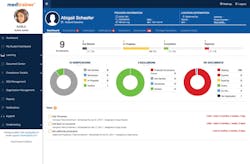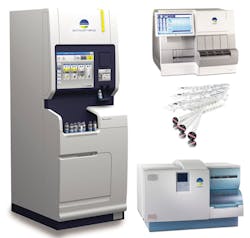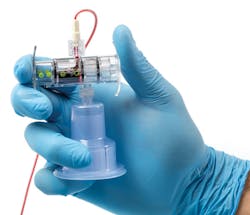In Osterholm and Olshaker’s book Deadliest Enemy: Our War Against Killer Germs,1 readers are exposed to the ugly reality of what life could be like if antibiotics no longer can save us from common infections. The authors tell us, “Microbes move in the direction of resistance in order to survive. And that movement, increasingly, threatens our survival. … With each passing year, we lose a percentage of our antibiotic firepower. In a very real sense, we confront the possibility of revisiting the Dark Age where many infections we now consider routine could cause severe illness, when pneumonia or a stomach bug could be a death sentence.”
The authors go on to say that, without antibiotics, any surgery would be so risky that only the most critical would be performed. The risks of open-heart surgery, organ transplants, or joint replacements could outweigh the benefits. “There would be no more in vitro fertilization,” said Osterholm and Olshaker.1 “Caesarian delivery would be far more risky. Cancer chemotherapy would take a giant step backwards, as would neonatal and regular intensive care … no one would go into a hospital unless they absolutely had to because of all the germs … Rheumatic fever would have lifelong consequences. TB sanitaria could be back in business. You could just about do a post-apocalyptic sci-fi movie on the subject.”
The Review on Antimicrobial Resistance2 describes some of the more global effects of antimicrobial resistance: “… 300 million people may die prematurely because of drug resistance over the next 35 years and the world’s GDP will be 2 to 3.5% lower than it otherwise would be in 2050. This means that between now and 2050 the world can expect to lose between 60 and 100 trillion USD worth of economic output if antimicrobial drug resistance is not tackled. This is equivalent to the loss of around one year’s total global output over the period, and will create significant and widespread human suffering. Furthermore, in the nearer term we expect the world’s GDP to be 0.5% smaller by 2020 and 1.4% smaller by 2030 with more than 100 million people having died prematurely.”
The Review on Antimicrobial Resistance2 also highlights the role of the speed and volume of intercontinental travel, which allows antimicrobial-resistant pathogens to spread globally quickly, “creating new resistant strains at an unprecedented pace. No country can therefore successfully tackle AMR [antimicrobial resistance] by acting in isolation. This is a looming global crisis, yet one which the world can avert if we take action soon.”
Among efforts that the United States has initiated are President Obama’s National Action Plan to Combat Antibiotic-Resistant Bacteria and The Joint Commission’s New Antimicrobial Stewardship Standard. Wendy Prins, MPH, MPT, Senior Advisor, Quality Innovation, National Quality Forum (NQF), referred to these when she said, “It’s important on so many fronts for our nation to address this epidemic. These steps have raised visibility—and have served as rallying cries—for action on an urgent healthcare issue facing our nation.”
Craig Barrett, PharmD, BCPS, Senior Product Director, Premier Inc., agreed. “These actions have helped to support organizations in complying with efforts to address AMR in a timely, efficient, and cost-effective manner. This has increased organizational focus to ensure a plan is in place that improves stewardship and creates an environment of accountability. Especially critical are the mandates to submit antibiotic-use resistance data, which allow organizations to benchmark outcomes against peers to identify improvement opportunities.”
Amanda Jezek, Senior Vice President, Public Policy and Government Relations, Infectious Diseases Society of America (IDSA), talked about the effects of federal actions currently being taken to address AMR in the United States. “Federal leadership helps elevate AMR and stewardship as national priorities, helping to raise their profile in individual facilities and communities. The federal government can also help to ensure that efforts to address AMR and implement stewardship are coordinated across federal agencies, healthcare facilities, etc.
“Further,” continued Jezek, “the federal government is an essential funder of research, surveillance, and public-health interventions to combat AMR. The National Action Plan for Combating Antibiotic Resistant Bacteria (CARB) galvanized many of these efforts, and the Strategies to Address Antimicrobial Resistance (STAAR) Act would codify sections of CARB to ensure continued progress. The STAAR Act would authorized strengthened surveillance activities, which are essential to provide up-to-date data and trends on the scope of the problem, which help us evaluate and target response efforts. STAAR would also authorize grants for healthcare facilities to support the implementation and study of antimicrobial stewardship programs (ASPs).”
Prins said, “Successful ASPs will have key partnerships between physicians and pharmacists, clearly articulated support from hospital leadership, a champion (or champions) among staff, and resources for appropriate staff and education.” She added that, ideally, multidisciplinary teams will guide the hospitals’ ASP initiatives, tracking progress—and accountability—with performance measurement.
Prins referred to the position of the highest public-health agency in the nation on ASPs. “The Centers for Disease Control and Prevention (CDC) recommends that all acute-care hospitals in the U.S. implement an ASP, and the agency’s ‘Core Elements of Hospital Antibiotic Stewardship Programs’3 outlines the seven elements of a successful program. However, many hospitals struggle both with how to start and with making the case for the needed resources, even though we know from CDC data that drug-resistant bacteria cause 2 million illnesses and 23,000 deaths annually.”
Two million illnesses attributed to drug-resistant bacteria come with a high price tag. “As antibiotic-resistant infection rates rise in the U.S., we are learning more about the cost of treating these infections,” continued Prins. “According to a March 2018 study in
Health Affairs,4 antibiotic resistance adds nearly $1,400 to the cost of treating a patient with a bacterial infection, amounting to a cost of $2.2 billion annually.”
Prins explained that the NQF’s ‘National Quality Partners Playbook: Antibiotic Stewardship in Acute Care’5 “demystifies the process of implementing and improving an ASP, with flexible and practical implementation advice and resources in one document. With nearly 38,000 downloads and anecdotal feedback from hospitals across the country that have used the NQP Playbook, it has become an essential guide for hospitals.”
“ASPs for acute-care settings are a good start to improve antibiotic stewardship, but other healthcare settings can do more to improve appropriate antibiotic use.” She noted that a new “NQP Playbook,” providing antibiotic stewardship guidance for the long-term–care community, is expected to be released this summer.
Challenges
Aaron Glatt, MD, Spokesman for IDSA and Chairman, Department of Medicine, and Hospital Epidemiologist at South Nassau Communities Hospital, Oceanside, NY, said, “IDSA is strongly supportive of antimicrobial stewardship.” Glatt does not understand why any hospital would not have an ASP. “It is unbelievably positive,” he said, “because it improves patient care and saves lives as well as money. Perhaps some medical facilities don’t have the resources or personnel, but an ASP clearly works in every respect, including but not limited to, public health, patient health, and economics.”
Steve Gallion, CEO, MedTrainer, offered a few more reasons why some medical facilities may be slow to implement an ASP. “The reluctance may be rooted in the limited availability of infectious-disease training, inadequate information technology resources, and the need to integrate more advanced clinical decision support.”
Barrett, Premier Inc., believes that the desire to create an ASP is not the issue. “Healthcare leaders clearly understand the value of an ASP, but executing an effective program is challenging.”
Barrett outlined three basic capabilities healthcare organizations should have to ensure they are ready to implement a successful ASP: (1) expertise—clinical pharmacy staff who understand how to, and can devote the time necessary to, stand up an effective program; (2) technology—surveillance and analytic tools that are customizable and able to support cross-continuum and service-line coordination, diverse patient populations, and the real-time data necessary to drive ASP goals; and, (3) data—trusted insights gleaned from a combination of robust outcomes-based and real-time information to alert clinical staff to intervene.
“Once the foundational capabilities of expertise, technology, and data are in place, organizations should follow the CDC’s recommendations for ASP implementation, to create a culture that is committed to antibiotic stewardship,” stated Barrett. “This includes having a dedicated clinical pharmacist, an infectious-disease physician, an infection-prevention liaison, and strong leadership alignment. ASP staff should work together to set goals, establish metrics, and determine a plan for reevaluation.”
According to Barrett, components of successful ASPs include real-time antibiograms, with available analytics; dashboards and reporting, to target ASP efforts and report up; coordinated real-time alerts and corresponding adjustments to therapy, probable isolation, and patient, family, and staff education.
“It is essential for ASP teams to leverage the right technology to stand up the ASP and standardize the health system’s approach.” Barrett cited some impressive statistics gleaned from members of Premier. “Premier members who leveraged technology and expertise to drive successful ASPs have reduced their use of antibiotics by 32 percent, improved appropriate antibiotic prescribing by 286 percent, and reduced the odds of infection-related mortality by 76 percent.”
Kate Shea, MD, Clinical Director for Infectious Diseases at Cardinal Health in the Clinical Quality Services Department, servicing the US and Puerto Rico, commented, “Common challenges with implementing ASPs include leadership support and available resources. In a recent publication by the CDC, written leadership support was identified as the strongest predictor of achieving all seven core elements of hospital ASPs. Despite the documented benefits of ASPs,6 facilities may not want to dedicate resources prior to regulatory mandates or requirements.
“The CDC’s Core Elements of Hospital ASPs includes leadership commitment, accountability, drug expertise, action, tracking, reporting, and education as key components for a successful ASP. Based on recent hospital survey results, implementation of all the CDC’s Core Elements of Hospital ASPs has increased by 20 to 25 percent in 2016 compared to 2014.6,7 Since The Joint Commission’s requirement, we see more hospitals developing an ASP to comply with the required standard,” added Shea.
“We find leadership support and inclusivity of all hospital prescribers essential to success,” said Shea. “The utilization of information technology can further assist with successful implementation of required elements such as action (e.g., implementation of multidisciplinary protocols), tracking (e.g., antimicrobial utilization), and reporting (e.g., reports on antibiotic use).
Shea explained that the “Cardinal Health Antimicrobial Stewardship Service provides a three-tiered approach, including assessment, implementation, and antimicrobial analytics. A four-phased approach is utilized to assess the ASP and develop an action plan. We provide resources to assist with implementation, tracking, reporting, and healthcare-practitioner education. The Cardinal Health antimicrobial analytics program tracks antimicrobial utilization with comparison versus the hospital’s baseline, as well as the Cardinal Health hospital-network benchmark.”
Shea also described the experience of a Cardinal Health Antimicrobial Stewardship Service user. “In a 421-bed level-II trauma center located in the Mid-Atlantic, opportunities were identified in 2015 based on initial assessment of the ASP and antimicrobial expenditure compared to benchmark via our antimicrobial analytics. The results of implementing the recommended action plan led to 176 percent and 185 percent improved compliance in all ASP phases and in the regulatory phase. Additionally, roughly a one-million–dollar annual-expenditure reduction was experienced.”
The Review on Antimicrobial Resistance2 stated there is an “urgent need to improve the surveillance of infections, and the rising tide of drug-resistant infections.” That is the purpose of BD’s antimicrobial stewardship solution, the BD MedMined Surveillance Advisor. Chad Glover, Vice President and General Manager, MedMined at BD, explained its objectives and how they are achieved. “The primary goals of an ASP are to optimize antimicrobial utilization, improve patient outcomes, and reduce antimicrobial resistance.
“BD MedMined provides customized, near real-time notifications and robust analytics to optimize antimicrobial utilization and minimize therapies that contribute to pathogen resistance. BD MedMined helps to identify and alert clinicians of a patient’s need for an antibiotic, alternative treatment, or discontinuation of therapy, based on the analysis of patient laboratory and pharmacy data. It helps to reduce antimicrobial resistance by monitoring, alerting, and providing timely reports of infections and multidrug-resistant pathogens. He provided an example: “ASP team members can be notified if a sepsis patient is not receiving protocol-driven antimicrobial therapy or when a patient is eligible for narrowed antibiotic coverage.”
By integrating and standardizing complex data elements, BD MedMined also provides insights that enable comparative evaluation and trending of antibiotic use and resistant pathogens. “It also provides key performance indicators needed to measure and optimize the work of successful ASPs,” said Glover.
Glover recounted the experience of a 500-bed teaching hospital that had high utilization of quinolones and rising rates of quinolone-resistant pathogens. BD MedMined identified opportunities for interventions to reduce quinolone utilization and monitor results. “Over 7 years, quinolone utilization reduced by 60 percent and quinolone susceptibility improved for four pathogens.”
BD MedMined can help save costs because it can identify opportunities for clinicians to optimize and accelerate appropriate therapy, which may result in reduced length of stay, resource utilization, and an improved workflow for clinicians. “BD MedMined also provides integrated financial analysis of cost savings (e.g., hospital costs) aligned with documented interventions,” Glover said.
Blood culturing
Blood cultures are important because they identify the pathogen to be targeted. Often, a physician will make an educated guess and prescribe an antibiotic they think the patient might need while awaiting blood-culture results. If the physician guessed wrong, valuable treatment time has been wasted just when time may be of the essence.
Seth Toback, MD, Vice President of bioMerieux Medical Affairs, talked about the importance of speed in culturing as it relates to diagnosis and antibiotic management. “To help speed detection and treatment decisions, hospital ASPs often turn to the bioMerieux BacT/ALERT VIRTUO automated blood-culture system, VITEK 2 bacterial identification and antibiotic-susceptibility platform, and the VIDAS BRAHMS Procalcitonin (PCT) test for antibiotic management.” He added, “Complete automation, robotic bottle selection, high-fidelity optics, and new algorithms are incorporated to increase performance and time to detection.”
The bioMerieux VITEK 2 system uses advanced identification technology that enables identification of routine clinical isolates and provides high discrimination between species. The VITEK 2 software analyzes minimum inhibitory concentration patterns and detects phenotypes for most organisms tested. Rapid results allow clinicians to discontinue empirical therapy and prescribe targeted therapy, resulting in improved patient outcomes, enhancing the ASP.”
Toback related a user experience. “A very proactive ASP at St. Luke’s Magic Valley Medical Center in Twin Falls, ID, utilized the VIRTUO and VITEK 2 systems and saw dramatic improvements. With these tools, the team cut the hospital pharmacy’s expenditure on daptomycin from $256,000 down to $30,000. The average hospital length of stay for patients with uncomplicated pneumonia decreased by 40 percent, from 4.5 to 2.7 days, by reaching optimal therapy faster.8
“In 2017, our VIDAS PCT test was approved for antibiotic management in patients with sepsis and lower respiratory-tract infection,” continued Toback. “PCT-guided antibiotic therapy has demonstrated a significant reduction in antibiotic utilization, including a 38 percent reduction in overall antibiotic exposure for inpatients and a 51 percent reduction in overall antibiotic exposure for patients in the emergency department. One hospital in North Carolina reported that using VIDAS PCT for antibiotic management has reduced the antibiotic exposure in its intensive-care unit by 4 days per patient, with no adverse events.9
Magnolia Medical Technologies is another company that offers blood-culture products. Bob Gerberich, CCO, talked about how blood-culture contamination can cause misdiagnosis and how their product guards against it. “Blood-culture contamination has been an issue for patient safety and for antimicrobial stewardship for decades. On average, 35 percent to 50 percent of positive blood cultures are actually false positives due to contamination.10 Steripath is a mechanical initial specimen diversion device for blood-culture collection that has been clinically proven to virtually eliminate blood-culture contamination, which can lead to the misdiagnosis of bloodstream infections including sepsis.”11
“ Clinical confusion from false positives can lead to unnecessary and inappropriate use of antibiotics, extended length of stay and associated risk of hospital-acquired conditions, and increased healthcare costs.12 Successful ASPs are ultimately driven by change in clinician behavior, which takes a long time and requires more accurate, consistent, and reliable diagnostic information,” observed Gerberich. “Steripath eliminates the problem of blood-culture contamination at its source, thus completely removing clinical decisions around treatment associated with false-positive blood cultures.”
Gerberich related an experience of a Steripath user who successfully reduced use of vancomycin-based and other broad-spectrum antibiotic therapies used to treat sepsis.13 “In a retrospective comparison of vancomycin administration at the San Antonio Military Medical Center, vancomycin-days of therapy decreased by 20 percent from 49.56 to 39.31 days after the implementation of rapid diagnostics and an incremental 37 percent, from 39.31 to 24.87 days, after implementation of Steripath.
Addressing the expense of blood-culture contamination and false-positives, Gerberich said, “Blood-culture contamination represents a significant cost to the hospital. There have been six independent peer-reviewed published studies on the costs associated with a blood-culture–contamination event. Those studies indicate a range of costs per contamination event of $3,700 to over $8,000.” Gerberich suggested doing the math. “Assume conservatively a blood-culture–contamination event costs the institution an average of $3,500 per false-positive blood culture. An average 250-bed hospital experiences 300 false-positive blood cultures per year, which equals over a million dollars of avoidable costs per year in an average institution.”
What makes a successful ASP?
Tips from the experts
Aaron Glatt, MD, Spokesman for IDSA and Chairman, Department of Medicine, and Hospital Epidemiologist at South Nassau Communities Hospital, Oceanside, NY, offered this tip for a successful and effective ASP. “The most important components of a successful ASP are the infectious-disease physicians and the pharmacists. They have the expertise and the ability to influence the appropriate people. This collegiality helps to ensure a successful ASP.” Glatt related that his own hospital has had great responses, because “the physicians listen to the infectious-diseases professionals’ and pharmacists’ advice about antimicrobial use.”
Chad Glover, Vice President and General Manager, MedMined, BD Digital Health, added, “Strong ASP teams include infectious-disease clinicians, hospital administration, pharmacy, microbiology, nursing, and information technology. Hospital administration must recognize the importance beyond the metric of decreasing antimicrobial usage. Appropriate awareness requires a coordinated, multidisciplinary team communicating meaningful data related to infections, pathogen and susceptibility trends, and multidrug-resistant treatment therapies.”
According to Seth Toback, MD, Vice President of bioMerieux Medical Affairs, “The most successful ASPs combine cutting-edge diagnostics and ID/AST technology with a highly motivated and proactive antimicrobial stewardship team where the laboratory, pharmacy, and clinicians work very closely to select and adjust therapy, based on the data from these advanced analytic systems.”
Steve Gallion, CEO, MedTrainer, believes, “An organization should start by analyzing the current patient population and the processes involved with prescribing antibiotics, then determine the opportunities for intervention and decision support, including training. Results should be shared in the aggregate and at the clinician/physician level, with the goal of reinforcing appropriate antibiotic prescribing.
“MedTrainer provides a compliance management system that can be used to distribute protocols and elicit support among leaders, physicians, and clinicians, and allows leadership and stakeholders to access pieces of critical information,” stated Gallion. “This all-in-one system offers a streamlined solution that is more efficient than current sharing programs and email trails. When healthcare providers are working toward a goal to reduce antibiotic prescribing, they must provide guidelines, training, and a format for feedback that is easy to use, flexible, and informative for the initiative to be effective.”
Gallion referred to published literature supporting MedTrainer’s recommendations for creating a baseline, developing protocols or policies, creating clinical guidelines, implementing continued improvements through the gathering of data, and measuring the appropriate reduction of antibiotics.3,14,15 “It is imperative that organizations develop a formal process for a responsive and adaptive ASP, to address both current and future challenges.”
References
- Osterholm MT, Olshaker M. Deadliest Enemy: Our War Against Killer Germs. Little, Brown and Company, New York; 2017.
- Review on Antimicrobial Resistance. Antimicrobial Resistance: Tackling a Crisis for the Health and Wealth of Nations. 2014. https://amr-review.org/sites/default/files/AMR%20Review%20Paper%20-%20Tackling%20a%20crisis%20for%20the%20health%20and%20wealth%20of%20nations_1.pdf. Last accessed April 30, 2018.
- Centers for Disease Control and Prevention. Core Elements of Hospital Antibiotic Stewardship Programs. https://www.cdc.gov/antibiotic-use/healthcare/implementation/core-elements.html#. Last updated February 23, 2017. Last accessed May 2, 2018.
- Thorpe KE, Joski P, Johnson KJ. Antibiotic-resistant infection treatment costs have doubled since 2002, now exceeding $2 billion annually.
Health Affairs 2018;37(4). - National Quality Forum. National Quality Partners Playbook: Antibiotic Stewardship in Acute Care. Washington, DC: NQF; May 2016. http://www.qualityforum.org/Publications/2016/05/National_Quality_Partners_Playbook__Antibiotic_Stewardship_in_Acute_Care.aspx. Last accessed May 1, 2018.
- O’Leary EN, van Santen KL, Webb AK, et al. Uptake of antibiotic stewardship programs in US acute care hospitals: findings from the 2015 National Healthcare Safety Network annual hospital survey.
Clin Infect Dis 2017;65:1748-1750. - Srinivasan A. Implementing antibiotic stewardship in rural and critical access hospitals [webinar]. Webinar presentation at the Centers for Disease Control and Prevention and Federal Office of Rural Health Policy. “Be aware: antibiotic stewardship for critical access hospitals”; November 16, 2017.
- Buckley B. ‘Bug squad’ squashes barriers to optimal antibiotic Rx.
Pharmacy Practice News. January 7, 2016. https://www.pharmacypracticenews.com/Clinical/Article/01-16/%E2%80%98Bug-Squad%E2%80%99-Squashes-Barriers-to-Optimal-Antibiotic-Rx/34802. Last accessed May 2, 2018. - Feinstein D. The war against superbugs starts here in North Carolina. May 5, 2017; updated May 6, 2017.
The News & Observer. http://www.newsobserver.com/opinion/op-ed/article148852079.html. Last accessed May 2, 2018. - Gander RM, Byrd L, DeCrescenzo M, et al. Impact of blood cultures drawn by phlebotomy on contamination rates and health care costs in a hospital emergency department. J Clin Microbiol. 2009;47(4):1021-1024.
- Rupp ME, Cavalieri RJ, Marolf C, et al. Reduction in blood culture contamination through use of initial specimen diversion device. Clin Infect Dis. 2017 Jul 15;65(2):201-205.
- Hall KK, Lyman JA. Updated review of blood culture contamination.
Clin Microbiol Rev. 2006;19(4):788‐802. - Chang D, Nielsen L, Ager E, et al. Impact of blood culture diversion device on molecular pathogen identification on vancomycin use. Poster presented at: Society for Healthcare Epidemiology of America, 2017; March 29-31, 2017; St. Louis, MO. Abstract 9010.
- Kapadia SN, Abramson EL, Carter EJ, et al. The expanding role of antimicrobial stewardship programs in hospitals in the United States: lessons learned from a multisite qualitative study. Jt Comm J Qual Patient Saf. 2018 Feb;44(2):68-74. http://www.jointcommissionjournal.com/article/S1553-7250(17)30160-5/pdf. Last accessed May 2, 2018.
- Jungman E. FDA Releases Draft Guidance on Antibiotic Policies under the GAIN Act. PEW Charitable Trusts; April 20, 2018. http://www.pewtrusts.org/en/research-and-analysis/analysis/2018/04/20/fda-releases-draft-guidance-on-antibiotic-policies-under-the-gain-act. Last accessed May 2, 2018.
About the Author

Susan Cantrell
Susan Cantrell is Infection Prevention Editor for Healthcare Purchasing News.








